Remember racing home after school to raid the pantry for those colorful packages that promised a burst of artificial flavor and pure joy? The 1970s were the golden age of snack innovation—before anyone worried much about high-fructose corn syrup or food dye numbers. While some classics have survived the decades, many of our childhood favorites have mysteriously vanished from store shelves, leaving only the sweet memories of sticky fingers and sugar rushes. Let’s take a nostalgic journey back to the era of orange shag carpets and wood-paneled station wagons as we mourn these 14 discontinued treats that deserve a comeback tour.
1. Space Food Sticks

Pillsbury’s Space Food Sticks let every 70s kid pretend they were floating alongside the Apollo astronauts with every chewy bite. These cylindrical protein snacks came individually wrapped in flavors like chocolate, peanut butter, and caramel, marketed as the same nutritious fuel that powered our space heroes. What made these sticks truly special was their unique texture—not quite candy, not quite energy bar—they existed in their own special food category. According to The Henry Ford, Pillsbury was personally contacted by NASA to design food for its astronauts.
The commercials promised us “energy food of the astronauts,” making us feel like we were training for NASA with every bite. Space Food Sticks disappeared from American shelves in the early 80s, though Australia kept their version around longer, proving that sometimes our cosmic neighbors down under have better taste than we do. Their disappearance left a freeze-dried void in our snack universe that modern protein bars, despite their nutritional superiority, simply cannot fill with their boring rectangular conformity.
2. Marathon Bar

The Marathon Bar was the chocolate-covered caramel braid that taught us the value of patience with its impressive eight-inch length. Mars advertised it with the slogan “Marathon lasts a good long time” and included a ruler on each wrapper to prove they weren’t exaggerating about this candy commitment. The twisted rope design made eating it an experience—you could unravel it, bite off small pieces, or (if you were particularly brave) attempt to fit the entire thing in your mouth. Bulk Candy Store further puts into context the history of this unique bar’s introduction into American taste buds and culinary culture.
This beloved bar met its untimely demise in 1981 after an eight-year run that left chocolatey fingerprints on our collective memory. Many fans believe the UK’s Curly Wurly is its closest living relative, though American devotees argue nothing truly captures the Marathon’s perfect texture and satisfying longevity. The Marathon represented everything wonderful about 70s excess—why have a normal-sized candy bar when you could have one that requires endurance training to complete?
3. Nabisco Swiss Cheese Crackers
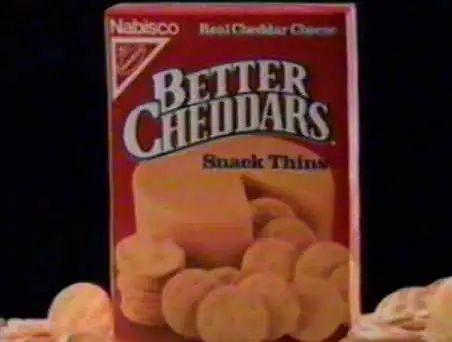
Nabisco’s Swiss Cheese crackers brought sophisticated European flavor to our lunchboxes with their distinctive hole-filled design that perfectly mimicked actual Swiss cheese. The crispy, airy crackers had just the right amount of artificial cheese flavor that somehow managed to convince our young palates it was remotely related to actual dairy products. Their perfect hexagonal shape made them architecturally interesting—you could build little cracker structures before devouring your creation. Smithsonian Magazin reveals just what a remarkable history the Cheeze-It as a whole concept has upon its inception.
Despite their popularity among kids whose parents were trying to offer something slightly more nutritious than cookies, these cheesy delights disappeared sometime in the early 80s. Cheese Nips and Cheez-Its survived while Swiss Cheese crackers quietly vanished, proving that the snack world can be as random and cruel as any other aspect of life. Every once in a while, a former fan starts an online petition to bring them back, but Nabisco remains unmoved by our collective grief.
4. Reggie! Bar

The Reggie! Bar combined America’s two great pastimes—baseball and excessive sugar consumption—into one star-powered package. Named for baseball great Reggie Jackson after he joined the Yankees in 1976, this round chocolate-covered peanut and caramel patty caused literal riots when they were handed out free during a Yankees game in 1978. The candy’s slogan “Reggie, Reggie, Reggie” echoed the chants heard in stadiums, creating the perfect synergy between sports fandom and impulsive snack purchases.
Standard Brands discontinued the original version in the early 80s, briefly reviving it when Jackson joined the Angels, before it struck out permanently from the candy lineup. While modern athletes endorse everything from underwear to insurance, there was something special about a candy bar that promised you could literally consume a piece of your sports hero’s success. The Reggie! Bar’s disappearance robbed future generations of the simple pleasure of eating a celebrity’s name in chocolate form after watching them hit a home run.
5. Screaming Yellow Zonkers

Screaming Yellow Zonkers wasn’t just a popcorn snack—it was a psychedelic experience in a box that perfectly captured the transitional vibe between the 60s and 70s. The yellow glazed popcorn came in a distinctive black box covered with absurdist humor and instructions like “Open box at this end” printed on the bottom. Each package was a masterclass in offbeat marketing, featuring random facts, surreal illustrations, and nonsensical advice that made reading the box almost as entertaining as eating the contents.
Lincoln Foods created a cult classic that made other caramel corns seem boring by comparison, despite containing basically the same ingredients. The Zonkers disappeared in the 2000s after several corporate acquisitions, with a brief, tantalizing comeback in 2012 that cruelly reignited our hopes before dashing them again. Their absence proves that sometimes it’s not just the flavor we miss but the entire quirky personality of a snack that became part of our cultural consciousness.
6. Pizzarias Pizza Chips
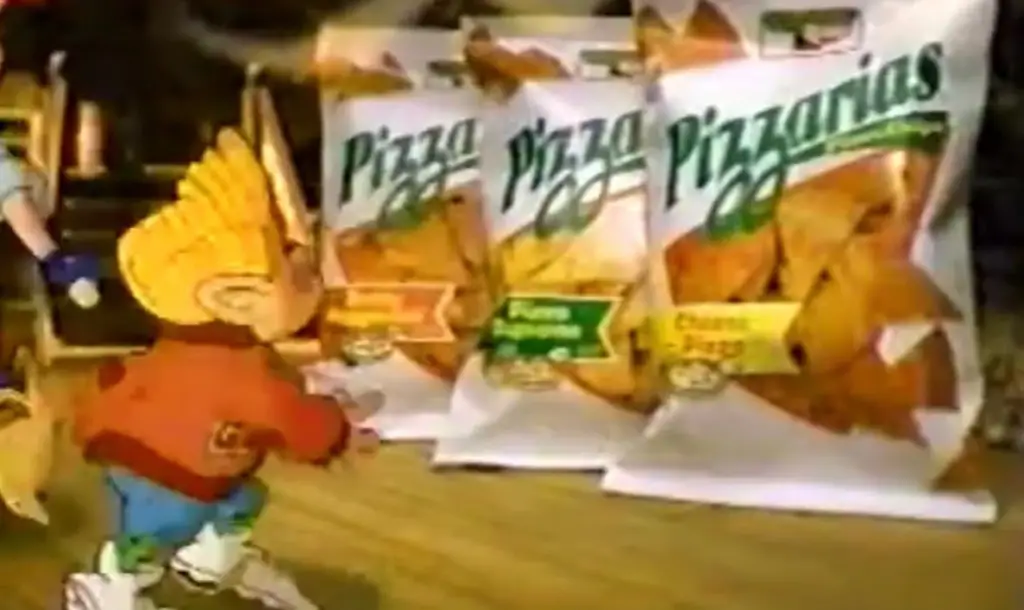
Keebler’s Pizzarias Pizza Chips delivered revolutionary pizza flavor in a convenient triangular chip form long before Doritos thought to introduce their pizza-flavored tortilla chips. These crispy wonders somehow captured the essence of tomato sauce, cheese, and herbs in a shelf-stable snack that turned your fingertips an authentic orange-red, just like real pizza grease would. Their unique texture—somewhere between a chip and a cracker—made them substantial enough to hold up to dips but perfect for straight-out-of-the-bag consumption.
Despite a loyal following and innovative flavor concept, Pizzarias disappeared in the 1990s after gracing our taste buds for over a decade of pizza-flavored perfection. Their demise created a specific pizza-chip-shaped hole in the snack aisle that competitors have tried and failed to fill with lesser imitations. Even in today’s world of extreme flavors and crossover snack concepts, the simple perfection of Pizzarias remains unmatched—a lost artifact from a time when turning one beloved food into the form of another was still revolutionary.
7. Jell-O 1-2-3

Jell-O 1-2-3 was the dessert equivalent of a magic trick, separating into three distinct layers as it set in the refrigerator. The top layer was a light whipped cream-like foam, the middle a mousse-type texture, and the bottom traditional Jell-O—all from one simple powder mixed with water. This dessert marvel made any 70s kid feel like they were dining at a fancy restaurant, even if they were just sitting at a laminate kitchen table under fluorescent lighting.
General Foods introduced this miracle dessert in 1969 and broke America’s heart by discontinuing it in 1996, before many millennials could experience the joy of watching science happen in their dessert cups. The fact that it required no special technique—just adding water and refrigerating—made it especially democratic, allowing even the most culinarily challenged families to present a visually impressive dessert. Modern attempts to recreate it at home involve multiple steps and ingredients, missing the beautiful simplicity of the original powder that knew how to sort itself out without human interference.
8. Hostess Pudding Pies
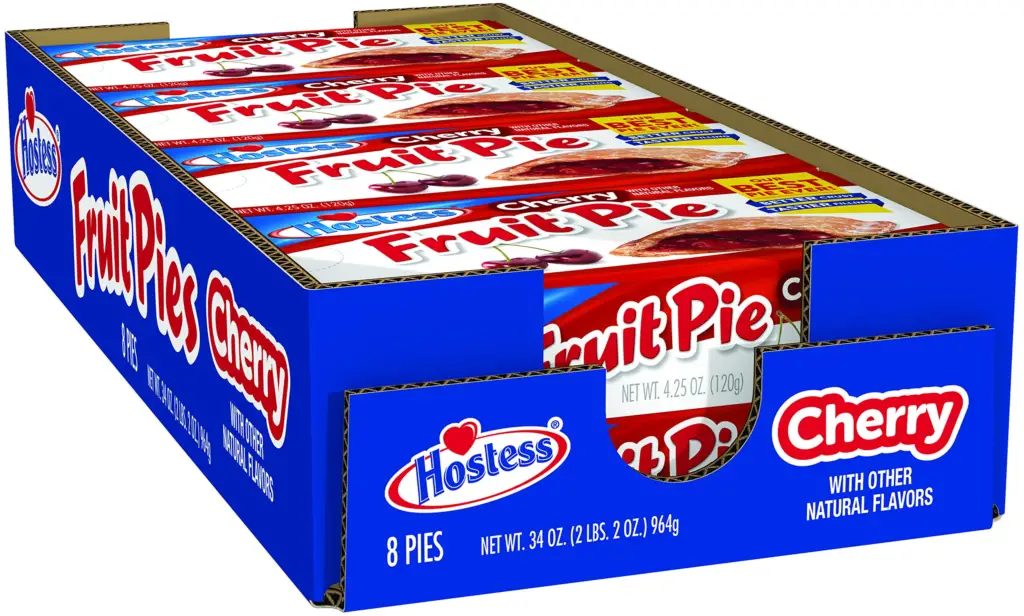
Hostess Pudding Pies were the perfect handheld delivery system for smooth, creamy pudding encased in a tender pie crust and covered with a glaze that somehow resisted melting even on hot playground days. Available in chocolate, vanilla, and coconut cream varieties, these palm-sized pies made lunchtime trading a high-stakes game of dessert diplomacy. The substantial weight of each pie made them feel like a serious commitment—a pudding experience that demanded your full attention.
While Hostess has survived bankruptcy and continues to make fruit pies, the pudding varieties disappeared sometime in the 1980s, though memories of their rich texture persist among dedicated fans. The unique cold, creamy filling was unlike anything else in the prepackaged dessert world—neither cake, cookie, nor traditional pie, but something gloriously unclassifiable. Their absence represents a textural diversity that’s missing from today’s snack landscape, where everything seems to be crunchy, chewy, or some combination of the two.
9. Dynamints

Dynamints came in a sleek plastic stick that made a satisfying “click” sound when opened, adding a touch of adult sophistication to the candy experience. The small, compressed breath mints were more intensely flavored than today’s versions, with the cinnamon variety packing enough punch to make your eyes water. The container design was truly revolutionary—a sliding mechanism revealed just one mint at a time, preventing the socially awkward fumbling that plagued users of traditional mint tins.
Made by Kenner (better known for Star Wars toys), these mints disappeared in the early 80s despite their innovative dispenser and potent flavoring. The clever dispenser design was genuinely ahead of its time, solving a problem we didn’t know needed solving—how to discreetly access a single mint without exposing the entire contents to the elements or having to dig around with potentially unclean fingers. Their disappearance means younger generations will never know the small but significant pleasure of sliding open a Dynamint dispenser during a boring class or meeting.
10. Handi-Snacks Ritz Treats
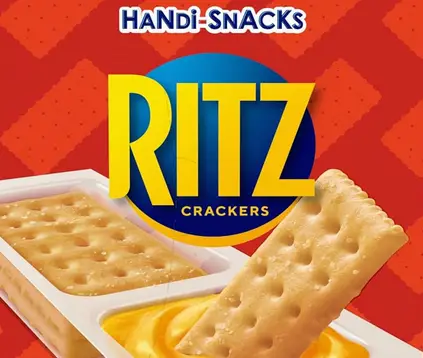
Ritz Handi-Snacks offered something truly magical for kids in the ’70s and ’80s—a salty, crunchy cracker paired with a creamy cheese dip, all neatly packaged in a plastic tray with its own red spreading stick. It wasn’t just a snack, it was an experience. Whether you were the type to ration each cracker carefully or pile on the cheese all at once, the real joy came from that unmistakable snap of peeling back the top and diving in.
Today’s snack packs just don’t have the same charm. The original Handi-Snacks had a sense of ceremony to them—carefully scooping with that little red stick, often licking it clean like it was gourmet fare. They were a staple in lunchboxes, perfect for road trips, or hiding in the pantry for a satisfying after-school fix. And just like the pudding cups of the time, no one really questioned how that cheese dip could live happily on a shelf without a fridge—back then, we trusted the magic of snack science.
11. Fruit Float
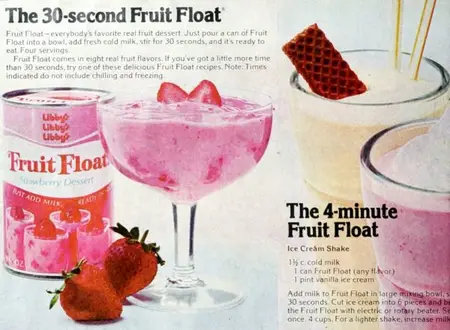
General Foods’ Fruit Float was the bizarre yet wonderful hybrid of fruit-flavored gelatin topped with a layer of creamy foam that somehow formed during preparation. Available in cherry, orange, and other fruity flavors, this dessert asked nothing of you except to add cold water and stir, then watch as science created distinct layers during refrigeration. The contrasting textures made every spoonful an adventure—smooth, creamy foam giving way to the slightly firmer fruit-flavored gelatin below.
Despite its magical self-layering properties and delightful texture contrast, Fruit Float disappeared from shelves in the late 70s after a relatively short market life. Its demise feels particularly criminal because it solved a problem we didn’t know we had—regular gelatin was apparently too boring with its single-texture experience. The concept was similar to Jell-O 1-2-3 but streamlined into just two layers, making it the perfect option for those who found three layers unnecessarily complex but one layer insufficiently fancy.
12. Gatorgum
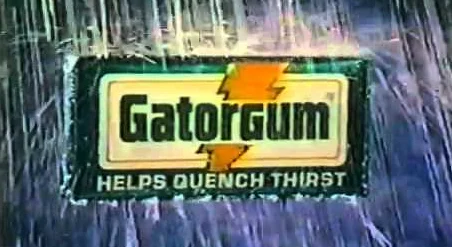
Quaker Oats’ Gatorgum combined the adult concept of electrolyte replacement with the kid-friendly delivery system of chewing gum, creating an unlikely crossover hit. Available in lemon-lime and orange flavors that matched the original Gatorade offerings, this gum promised to “quench your thirst” despite being a product you couldn’t actually swallow. The packaging featured the same distinctive Gatorade lightning bolt, lending athletic credibility to what was essentially just tangy gum.
Discontinued in 1989 after a ten-year run, Gatorgum had an intensely sour first impression that mellowed into a surprisingly long-lasting flavor—not unlike the burn of athletic achievement giving way to the satisfaction of accomplishment. While the gum likely provided zero actual hydration benefits, chewing it somehow made us feel like serious athletes, even if we were just walking to the corner store to buy more gum. Its disappearance deprived future generations of the character-building experience of trying to act cool while their eyes watered from that first intensely sour burst of flavor.
13. Munch ‘Ems
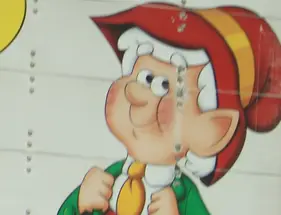
Keebler’s Munch ‘Ems were the perfect hybrid of crackers and chips, with the structural integrity of the former but the satisfying crunch and flavoring of the latter. These square snacks came in bold flavors like ranch, cheddar, and sour cream & onion, with ridges that efficiently delivered maximum seasoning to your taste buds. Their sturdy construction made them ideal for dipping, though they were flavorful enough to enjoy straight from the box.
After their introduction in the late 70s, these snacks enjoyed a good run before disappearing in the early 2000s, leaving fans with no comparable replacement. Their unique texture—crunchier than a cracker but more substantial than a chip—created a snacking category that remains unfilled in today’s landscape of either/or options. Munch ‘Ems represented the best of snack innovation: solving a problem we didn’t know we had by creating something that wasn’t quite one thing or another but somehow better than both.
14. Danish Go-Rounds
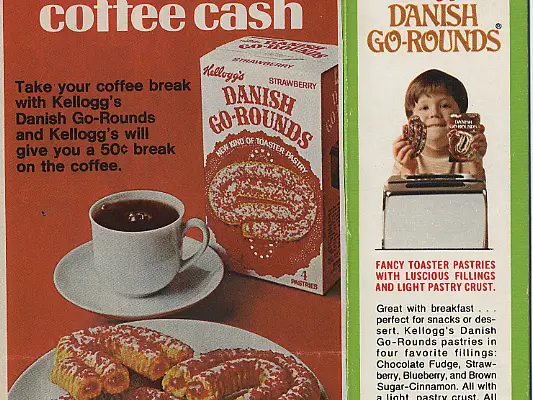
Kellogg’s Danish Go-Rounds were essentially flat Pop-Tarts twisted into a spiral shape, bringing the exotic sophistication of European pastries to American toaster ovens. These spiral-shaped breakfast treats came in flavors like raspberry, brown sugar cinnamon, and Dutch apple, with the filling swirled throughout rather than concentrated in the center. Their unique shape allowed for more edges to get crispy in the toaster, creating a superior texture experience to their rectangular cousins.
Introduced in 1968 and discontinued by the late 70s, Danish Go-Rounds fell victim to the overwhelming popularity of Pop-Tarts despite their superior design and more consistent filling distribution. The spiral format provided a more authentic pastry experience, evoking actual Danish pastries rather than just rectangular hand pies. Their disappearance represents a missed opportunity in breakfast innovation—a spiral path not taken in favor of the safer rectangle that continues to dominate the toaster pastry landscape to this day.
The disappearance of these iconic snacks represents more than just missing flavors—it’s the loss of shared cultural experiences that helped define a generation. These weren’t just treats; they were edible time capsules that connected us to specific memories: trading with friends at lunch tables, Saturday morning cartoon commercial breaks, and the simple joy of tearing open a new package. While today’s snack aisles overflow with options, something special remains missing—that specific combination of weird concepts, bold flavors, and zero nutritional guilt that made 70s snacking an adventure. Perhaps in our health-conscious era, these colorful, preservative-laden treasures can never truly return, but we’ll forever hold out hope for one more taste of these discontinued delights.


